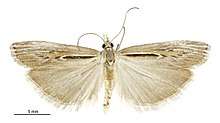Maoricrambus
Maoricrambus is a genus of moths of the family Crambidae.[2] It contains only one species, Maoricrambus oncobolus, which is endemic to New Zealand. This species is classified as Nationally Endangered by the Department of Conservation.
| Maoricrambus | |
|---|---|
 | |
| Male | |
| Scientific classification | |
| Kingdom: | |
| Phylum: | |
| Class: | |
| Order: | |
| Family: | |
| Genus: | Maoricrambus Gaskin, 1975[2] |
| Species: | M. oncobolus |
| Binomial name | |
| Maoricrambus oncobolus | |
| Synonyms | |
| |
Taxonomy
M. oncobolus was named by Edward Meyrick in 1885 and described using a specimen collected at Castle Hill Basin,[4][5] now part of the Kura Tāwhiti Conservation Area near Arthur's Pass.[6] In 1895 when listing the species George Hampson misspelt it resulting in the synonym for the species of Crambus oncolobus.[7][8] In 1975 D. E. Gaskin erected the monotypic genus Maoricrambus for Crambus oncolobus.[9] The lectotype and paralectotype specimens are held at the Natural History Museum, London.[9]
Description
Meyrick described the species as follows:
Male, female. — 24-27 mm. Head white. Palpi very long, white, externally slightly ochreous-tinged. Antennas whitish, in male shortly ciliated. Thorax white or greyish-white, shoulders ochreous. Abdomen whitish-ochreous. Legs white, anterior pair internally fuscous. Forewings elongate, narrow, tolerably dilated, costa gently arched, apex round-pointed, hindmargin straight, oblique, strongly rounded beneath ; pale fuscous ; all veins suffused with white, more or less confluent towards costa posteriorly, and obscurely margined with dark fuscous ; a narrow white central streak from base to middle of disc, its apex sharply hooked downwards, margined beneath throughout by a strong black streak finely attenuated at base, and its apex margined posteriorly with black ; above the white central streak is a yellow-ochreous streak becoming dilated beyond it and suffused into ground- colour, and beneath the black streak a yellow-ochreous streak reaching apex of hook ; an ill-defined strongly dentate blackish posterior transverse line, tending to separate into longitudinal dashes, sharply angulated outwards above middle, and sinuate inwards towards inner margin : cilia pale greyish, suffusedly barred with white, tips white. Hindwings pale grey ; cilia whitish-grey.[5]
M. oncobolus is very similar in appearance to Orocrambus harpophorus. However M. oncobolus does not have the subterminal spotting of the forewings that can be found on the forewings of O. harpophorus. Also the two species are dissimilar in both the male and female genital structure.[9]
Adults are on wing from December to February.[9]
Distribution
M. oncobolus is endemic to New Zealand.[3][10] This species is restricted to central Canterbury and Southland.[9] Specimens of this species have been collected at Porter River among the boulders and lichens near the edge of the river[11] and at the Sandy Point Domain near Invercargill.[12]
Habitat
M. oncobolus is associated with riverside grasslands in Southland and braided riverbeds central Canterbury.[13][11]
Host plants
The host plants of this species are unknown.[13]
Conservation status
M. oncobolus is regarded as being "Nationally Endangered" under the New Zealand Threat Classification System.[1]
References
- Patrick, Brian H.; Hoare, R.J.B. "Maoricrambus oncobolus". www.landcareresearch.co.nz. Landcare Research New Zealand Ltd. Retrieved 22 January 2018.
- "Maoricrambus Gaskin, 1975". www.nzor.org.nz. Landcare Research New Zealand Ltd. Retrieved 2 May 2018.
- "Maoricrambus oncobolus (Meyrick, 1885)". www.nzor.org.nz. Landcare Research New Zealand Ltd. Retrieved 2018-01-20.
- Meyrick, Edward (1885). "Description of New Zealand Microlepidoptera. V [VI]. Pyralidina [abstract]". New Zealand Journal of Science. 2: 346–348 – via Biodiversity Heritage Library.
- Meyrick, Edward (1885). "Descriptions of New Zealand Microlepidoptera. VI. Pyralidina". Transactions and Proceedings of the New Zealand Institute. 17: 121–140 – via Biodiversity Heritage Library.
- "Kura Tāwhiti Conservation Area". www.doc.govt.nz. New Zealand Department of Conservation. Retrieved 2018-05-03.
- Hampson, G. F. (1895). "On the classification of the Schoenobiinae and Crambinae, two subfamilies of moths of the family Pyralidae". Proceedings of the Zoological Society of London. 1895: 897–974.
- Dugdale, J. S. (1988). "Lepidoptera - annotated catalogue, and keys to family-group taxa" (PDF). Fauna of New Zealand. 14: 145–146 – via Landcare Research New Zealand Ltd.
- Gaskin, D. E. (1975). "Revision of the New Zealand Crambini (Lepidoptera: Pyralidae: Crambinae)". New Zealand Journal of Zoology. 2 (3): 265–363. doi:10.1080/03014223.1975.9517878.
- Gordon, Dennis P., ed. (2010). New Zealand inventory of biodiversity. Volume two. Kingdom animalia : chaetognatha, ecdysozoa, ichnofossils. Vol. 2. Christchurch, N.Z.: Canterbury University Press. p. 457. ISBN 9781877257933. OCLC 973607714.
- Gaskin, David E. (1987). "Supplement to New Zealand Crambinae (Lepidoptera: Pyralidae) — corrections, description of females of two species, and notes on structure, biology, and distribution" (PDF). New Zealand Journal of Zoology. 14 (1): 113–121. doi:10.1080/03014223.1987.10422688. Retrieved 3 May 2018.
- R. J. Pagan (31 July 2013). Management Plan Sandy Point Domain (Report). Invercargill City Council. p. 115.
|access-date=requires|url=(help) - Patrick, Brian; Dugdale, John S. (2000). Conservation status of the New Zealand Lepidoptera (PDF). Wellington, New Zealand: Department of Conservation. p. 28. ISBN 978-0478218671.
